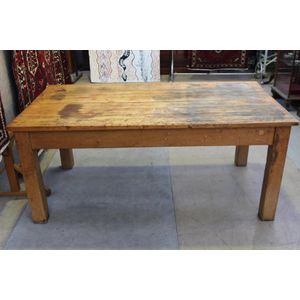French Inlaid Refectory Dining Table with Drawers
A French antique style refectory dining table, the rectangular top with repeating geometric lozenge inlays crossbanded with herring-bone, multiple frieze drawers to each side, the plain turned legs with reeded stretchers. Width 239 cm, depth 100 cm, height 76 cm.
You must be a subscriber, and be logged in to view price and dealer details.
Subscribe Now to view actual auction price for this item
When you subscribe, you have the option of setting the currency in which to display prices to $Au, $US, $NZ or Stg.
This item has been sold, and the description, image and price are for reference purposes only.
- Reeding - A series of parallel, raised convex mouldings or bands, in section resembling a series of the letter 'm'. The opposite form of fluting, with which it is sometimes combined. Reeding is commonly found on chair legs, either turned or straight, on the arms and backs of chairs and couches and around table edges in the Neoclassical or Classical Revival manner. Reeding was also used as a form of decoration during the Edwardian period, but it is usually much shallower and evidently machine made.
- Refectory Table - A long, substantial, solid-topped table, without leaves or extensions, used as a dining table. They were originally used in the refectories, or dining halls of monasteries, and are found in such places as boarding schools and university halls of residence. The tables usually have heavy turned legs, sometimes connected by stretchers close to the floor, and often have additional supporting legs along the railed frame. The term is also sometimes applied to a much shorter solid-topped table with a somewhat Jacobean flavour of the early 20th century.
- Turned Legs - are legs which have been turned on a lathe. In use from the 16th century, turned legs on tables, chairs and cabinets became more frequent until, by the 1830s, the Georgian square or tapered leg was rarely found except in country pieces.
- Herringbone Pattern in Furniture - The herringbone pattern is a popular decorative pattern used in furniture, created by inlaying small rectangular pieces of veneer in a zig-zag pattern, similar to the pattern found in the herringbone link used in jewellery. The pieces of veneer are cut at a 45-degree angle to create the distinctive V-shape, and are arranged in a way that creates a seamless, interlocking pattern.
The herringbone pattern in veneer can be used in a variety of ways in furniture design. It is commonly used on table tops, cabinet doors, and other flat surfaces, where it can add visual interest and texture to the piece. It can also be used on curved surfaces, such as the front of a chest of drawers or the top of a curved console table, where it can create a dramatic and eye-catching effect. - Turning - Any part of a piece of furniture that has been turned and shaped with chisels on a lathe. Turned sections include legs, columns, feet, finials, pedestals, stretchers, spindles etc. There have been many varieties and fashions over the centuries: baluster, melon, barley-sugar, bobbin, cotton-reel, rope-twist, and so on. Split turning implies a turned section that has been cut in half lengthwise and applied to a cabinet front as a false decorative support.
- Frieze - An architectural term denoting the flat, shaped or convex horizontal surface of furniture, between the architrave and the cornice, usually found on a cabinet or bookcase, or on desks and tables where it may include drawers, the area between the top and the legs. In ceramics, the term refers to the banding, of usually a repeating pattern, on the rims of plates and vases.
- Crossbanding - Crossbanding is a decorative technique used in furniture-making, where thin strips of wood, known as crossbands, are applied to the surface of a piece of furniture to create a decorative border or inlay. The crossbands are typically made of a different type of wood or a different color than the main piece of furniture, and are applied in a geometric pattern, such as a checkerboard or herringbone design.
Crossbanding was a popular decorative technique in furniture-making from the 17th to the 19th centuries, particularly in the Baroque, Rococo, and Chippendale styles. It was often used to create intricate patterns and designs on the surfaces of tables, desks, cabinets, and other pieces of furniture. The crossbands were often made of exotic woods, such as ebony or rosewood, which were imported from other parts of the world and were highly prized for their rich colors and patterns.
This item has been included into following indexes:
Visually similar items

Large Chinese pine oblong low table of planked construction
Sold by
in
for
You can display prices in $Au, $US, $NZ or Stg.

A cedar writing table, Australian, 19th century, 78 cm high, 107 cm wide, 52 cm deep, together with a mahogany balloon back chair
Sold by
in
for
You can display prices in $Au, $US, $NZ or Stg.

Pine farmhouse table on square legs (183 cm x 98 cm)
Sold by
in
for
You can display prices in $Au, $US, $NZ or Stg.

19th century mahogany and cedar dropside table with ring turned legs
Sold by
in
for
You can display prices in $Au, $US, $NZ or Stg.
